Online Gather.town Pitches
Novel Image Reconstruction Techniques III
Joint Annual Meeting ISMRM-ESMRMB & ISMRT 31st Annual Meeting • 07-12 May 2022 • London, UK

| Booth # | ||||
|---|---|---|---|---|
4680 |
1 | Regularized SUPER-CAIPIRINHA: accelerating 3D variable-flip-angle T1 mapping up to 16-fold with fast reconstruction
Fan Yang1, Jian Zhang2, Guobin Li2, Jiayu Zhu2, Xin Tang1, and Chenxi Hu1
1Institute of Medical Imaging Technology, School of Biomedical Engineering, Shanghai Jiao Tong University, Shanghai, China, 2United Imaging Healthcare Co., Ltd, Shanghai, China
Three-dimensional variable-flip-angle (VFA) T1 mapping is an accurate T1 quantification method suffering from long scan time. SUPER is a contrast-domain acceleration technique with strength in noise suppression and fast reconstruction. Here, we develop regularized SUPER-CAIPIRINHA to accelerate 3D VFA T1 mapping up to 16-fold with 10 flip angles, and perform fast reconstruction with the proposed proximal-Levenberg Marquardt algorithm. The novel method is validated with both retrospective and prospective experiments, compared to Locally Low Rank and Compressed Sensing. The results show that rSUPER-CAIPIRINHA is an accurate and computationally efficient technique, reducing the 3D scan time from 14:10 minutes to 0:59 minutes.
|
||
4681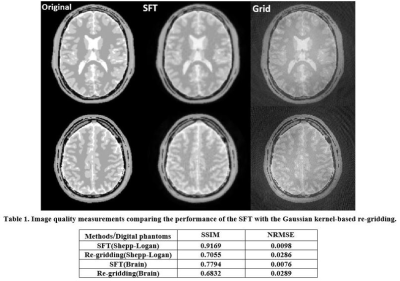 |
2 | A Novel Three-Dimensional k-Space Reconstruction Method by Spherical Fourier Transform
Mojtaba Shafiekhani1, Vahid Ghodrati2, and Abbas Nasiraei-Moghaddam1
1biomedical engineering, Amirkabir University of Technology (Tehran Polytechnic), Tehran, Iran (Islamic Republic of), 2Department of Radiological Sciences, University of California Los Angeles, Los Angeles, CA, United States
The two- and three-dimensional radial trajectory has been widely used due to its lower sensitivity to movement and flow and also shorter acquisition time. Re-gridding, the dominant approach for radial data reconstruction, suffers from severe artifacts at high acceleration rates. This study proposes a mathematical approach based on spherical harmonics to reconstruct images in the spherical coordinates without any interpolation in the frequency domain, unlike the conventional re-gridding algorithm. The feasibility of the proposed algorithm for reconstructing the images on both 3D Shepp-Logan and brain digital phantoms was shown.
|
||
4682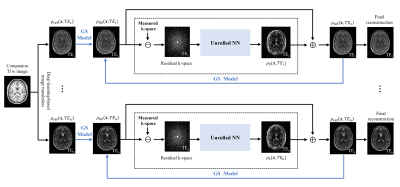 |
3 | Reconstructing T2 Maps of the Brain from Highly Sparse k-Space Data with Generalized Series-Assisted Deep Learning
Ruihao Liu1, Yudu Li2,3, Ziyu Meng1, Yue Guan1, Ziwen Ke1, Tianyao Wang4, Yao Li1, Yiping P. Du1, and Zhi-Pei Liang2,3
1School of Biomedical Engineering, Shanghai Jiao Tong University, Shanghai, China, 2Beckman Institute for Advanced Science and Technology, University of Illinois at Urbana-Champaign, Urbana, IL, United States, 3Department of Electrical and Computer Engineering, University of Illinois at Urbana-Champaign, Urbana, IL, United States, 4Radiology Department, The Fifth People's Hospital of Shanghai, Shanghai, China
Quantitative T2 maps of brain tissues are useful for diagnosis and characterization of a number of diseases, including neurodegenerative disorders. This work presents a new learning-based method for the reconstruction of T2 maps from highly sparse k-space data acquired in accelerated T2-mapping experiments. The proposed method synergistically integrates generalized series modeling with deep learning, which effectively captures the underlying signal structures of T2-weighted images with variable TEs and a priori information from prior scans (e.g., data from the Human Connectome Project). The proposed method has been validated using experimental data, producing improved brain T2 maps over the state-of-the-art methods.
|
||
4683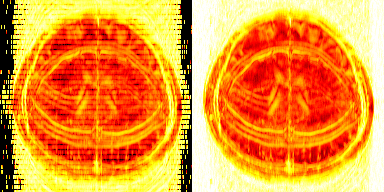 |
4 | Densely-overlapped locally low-rank algorithms outperform conventional locally low-rank algorithms for accelerating parametric mapping
Chenxi Hu1, Fan Yang1, Xin Tang1, Zhiyong Zhang1, and Dana Peters2
1Shanghai Jiao Tong University, Xuhui, China, 2Yale University, New Haven, CT, United States
The Locally Low-Rank (LLR) constraint has been increasingly used for MR acceleration. Here we compare two strategies for LLR-constrained reconstruction, namely the Non-overlapped LLR (NLLR) and the Densely-overlapped LLR (DLLR) to show their differences. The NLLR strategy has been used by a number of LLR algorithms, including the most well-known POCS algorithm. On the other hand, the DLLR strategy has not been well-recognized as a different strategy, and algorithms able to employ the strategy have only been developed recently. In this work, we show that DLLR is different and superior to NLLR by yielding faster convergence and reduced undersampling artifacts.
|
||
4684 |
5 | Boosting of Half-Quadratic Splitting Algorithm for Undersampled Brain MRI Reconstruction
Qingyong Zhu1, Jing Cheng2, Zhuo-Xu Cui1, Yuanyuan Liu3, Yanjie Zhu2, and Dong Liang1
1Research Center for Medical AI, SIAT, Chinese Academy of Sciences, Shenzhen, China, 2Paul C. Lauterbur Research Center for Biomedical Imaging, SIAT, Chinese Academy of Sciences, Shenzhen, China, 3National Innovation Center for Advanced Medical Devices, Shenzhen, China, Shenzhen, China
The existing accelerated MRI methods have the limitations such as fine-structure loss in the cases of high reduction factors or noisy measurements. This work presents a novel mutual-structure filtering based half-quadratic splitting algorithm for accurate undersampled brain MRI reconstruction. Experimental results on in-vivo images have shown that the proposed approach has a superior ability to capture meaningful details compared with other state-of-the-art reference guided reconstruction technologies.
|
||
4685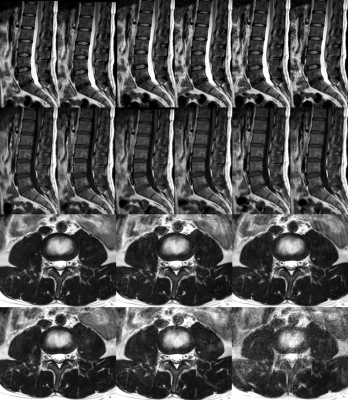 |
6 | Application of Compressed Sensing Technology in Rapid Lumbar Magnetic Resonance Imaging
Haonan Zhang1, Qingwei Song1, Ailian Liu1, and Geli Hu2
1Department of Radiology, the First Affiliated Hospital of Dalian Medical University, Dalian, Dalian, China, 2Philips Healthcare, Beijing, China, Beijing, China
Lumbar magnetic resonance imaging has a significant diagnostic value for spine lesions. Reducing scan time is critical to improve patient compliance and comfort. The purpose of this study aims to introduce a combination of compressed-sensing and parallel imaging for high acceleration and motion artifact reduction for the lumbar spine MRI, and to determine an optimal acceleration factor, meanwhile, provide high quality images .
|
||
4686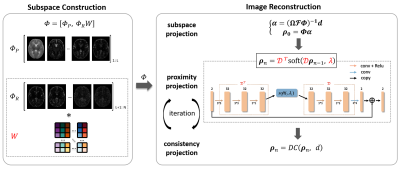 |
7 | Learned Subspace Model Enables Ultrafast Neonatal Brain MR Imaging
Ziwen Ke1, Yue Guan1, Yudu Li2, Yunpeng Zhang1, Tianyao Wang3, Ziyu Meng1, Ting Zhao1, Yujie Hu1, Ruihao Liu1, Huixiang Zhuang1, Zhi-Pei Liang2, and Yao Li1
1School of Biomedical Engineering, Shanghai Jiao Tong University, Shanghai, China, 2Beckman Institute for Advanced Science and Technology, University of Illinois at Urbana-Champaign, Urbana, IL, United States, 3Department Radiology, The Fifth People’s Hospital of Shanghai, Fudan University, Shanghai, China
Fast imaging is essential in neonatal brain MRI. Deep learning-based methods can provide high acceleration rates but their performance is instable when limited training data are available. Subspace model-based approach could reduce the dimensionality of imaging and improve reconstruction stability. This work presents a novel method to integrate neonate-specific subspace model and model-driven deep learning, making stable and ultrafast neonatal MR imaging possible. The feasibility and potential of the proposed method have been demonstrated using in vivo data from four medical centers, producing very encouraging results. With further development, the proposed method may provide an effective tool for neonatal imaging.
|
||
4687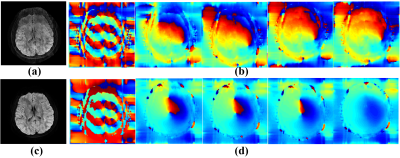 |
8 | Low-Rank Shot-phase Estimation for Multi-shot DWI Reconstruction
Chen Qian1, Zi Wang1, Xinlin Zhang1, Boxuan Shi1, Di Guo2, Boyu Jiang3, Ran Tao3, and Xiaobo Qu1
1Department of Electronic Science, Biomedical Intelligent Cloud R&D Center, Fujian Provincial Key Laboratory of Plasma and Magnetic Resonance, National Institute for Data Science in Health and Medicine, Xiamen University, Xiamen, China, 2School of Computer and Information Engineering, Xiamen University of Technology, Xiamen, China, 3United Imaging Healthcare, Shanghai, China
Diffusion-weighted imaging (DWI) is widely employed in clinical diagnosis and white matter connections mapping. Multi-shot interleaved echo planer imaging (ms-iEPI) is used for acquiring images with higher spatial resolution and fewer distortion but suffers from motion-induced shot-phase variations. In this work, a joint reconstruction model is proposed to obtain the shot-phase and composite magnitude image simultaneously. Specifically, the smoothness of the shot-phase is exploited to construct low-rank constraints. Experiment results show that the proposed method has better performance than state-of-the-art methods on shot-phase estimation and image reconstruction.
|
||
4688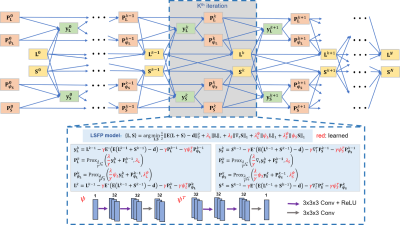 |
9 | A Deep Unrolled Network for Reconstruction of Real-time Interventional MRI with Multi-coil Radial Sampling
Zhao He1, Ya-Nan Zhu2, Yuchen He2, Yu Chen1, Suhao Qiu1, Linghan Kong1, Xiaoqun Zhang2, and Yuan Feng1
1School of Biomedical Engineering, Shanghai Jiao Tong University, Shanghai, China, 2School of Mathematical Sciences, MOE-LSC and Institute of Natural Sciences, Shanghai Jiao Tong University, Shanghai, China
Interventional MRI (i-MRI) needs fast data acquisition and image reconstruction. We have shown that a Low-rank and Sparsity decomposition with Framelet transform model with Primal dual fixed point optimization (LSFP) could satisfy the reconstruction of real-time i-MRI. In this study, we unrolled the LSFP into a deep neural network, dubbed LSFP-Net, with multi-coil golden-angle radial sampling. Simulation results showed that LSFP-Net outperformed the state-of-the-art methods, and a phantom experiment demonstrated its potential for real-time i-MRI.
|
||
4689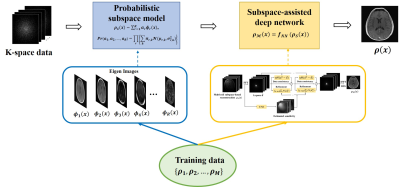 |
10 | Image reconstruction with subspace-assisted deep learning
Yue Guan1, Yudu Li2,3, Ruihao Liu1, Ziyu Meng1, Yao Li1, Leslie Ying4,5, Yiping P. Du1, and Zhi-Pei Liang2,3
1Institute for Medical Imaging Technology, School of Biomedical Engineering, Shanghai Jiao Tong University, Shanghai, China, 2Department of Electrical and Computer Engineering, University of Illinois at Urbana-Champaign, Urbana, IL, United States, 3Beckman Institute for Advanced Science and Technology, University of Illinois at Urbana-Champaign, Urbana, IL, United States, 4Department of Biomedical Engineering, The State University of New York at Buffalo, Buffalo, NY, United States, 5Department of Electrical Engineering, The State University of New York at Buffalo, Buffalo, NY, United States
Deep learning-based image reconstruction methods are often sensitive to changes in data acquisition settings (e.g., sampling pattern and number of encodings). This work proposes a novel subspace-assisted deep learning method to effectively address this problem. The proposed method uses a subspace model to capture the global dependence of image features in the training data and a deep network to learn the mapping from a linear vector space to a nonlinear manifold. Significant improvement in reconstruction accuracy and robustness by the proposed method has been demonstrated using the fastMRI dataset.
|
||
4690 |
11 | Cascaded hybrid k-space and image generative adversarial network for fast MRI reconstruction
Yuxuan Liu1, Yongsheng Pan1, Mancheng Meng1, and Haikun Qi1
1School of Biomedical Engineering, ShanghaiTech University, Shanghai, China
A cascaded hybrid domain generative adversarial network is proposed for accelerated MRI reconstruction. A novel multi-scale feature fusion sampling layer is proposed to replace the pooling layers and upsampling layers in the U-Net k-space generator to better recover the missing samplings. The proposed method is extensively validated with low and high acceleration factors against several state-of-the-art reconstruction methods, and achieves competitive reconstruction performance.
|
||
4691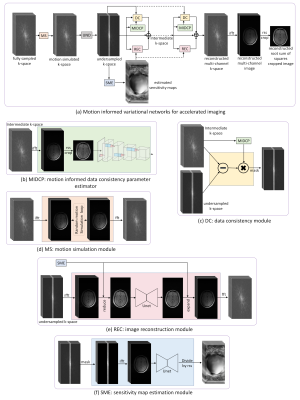 |
12 | Motion Aware Deep Learning Accelerated MRI Reconstruction
Kamlesh Pawar1,2, Gary F Egan1,2,3, and Zhaolin Chen1,4
1Monash Biomedical Imaging, Monash University, Melbourne, Australia, 2School of Psychological Sciences, Monash University, Melbourne, Australia, 3ARC Centre of Excellence for Integrative Brain Function, Monash University, Melbourne, Australia, 4Department of Data Science and AI, Faculty of Information Technology, Monash University, Melbourne, Australia
Deep learning (DL) models for accelerated image reconstruction involves retrospective undersampling of the fully sampled k-space data for training and validation. This strategy is not a true reflection of real-world data and in many instances, the input k-space data is corrupted with artifacts and errors, such as motion artifacts. In this work, we propose to improve existing methods of DL training and validation by incorporating a motion layer during the training process. The incorporation of a motion layer makes the DL model aware of the underlying motion and results in improved image reconstruction in the presence of motion.
|
||
 |
4692 |
13 | Fast and Automatic Rank Determination (ARD) via Deep Learning for Low-rank Calibrationless Reconstruction
Jiahao Hu1,2,3, Zheyuan Yi1,2,3, Yujiao Zhao1,2, Christopher Man1,2, Linfang Xiao1,2, Vick Lau1,2, Shi Su1,2, Ziming Huang1,2, Junhao Zhang1,2, Alex T.L. Leong1,2, Fei Chen3, and Ed X. Wu1,2
1Laboratory of Biomedical Imaging and Signal Processing, The University of Hong Kong, Hong Kong, China, 2Electrical and Electronic Engineering, The University of Hong Kong, Hong Kong, China, 3Electrical and Electronic Engineering, Southern University of Science and Technology, Shenzhen, China Low-rank matrix completion has emerged as a potent reconstruction approach for calibrationless parallel imaging. However, in all existing low-rank reconstruction methods, the rank threshold must be carefully chosen slice by slice in a manual and trial-and-error manner, severely hindering the adoption of low-rank reconstruction in routine clinical applications. To tackle the problem, we proposed a fast and automatic rank determination via deep learning. It directly determines optimal rank from undersampled k-space data by exploiting coil sensitivity and finite image support. Our proposed method enables fast, automatic and robust rank determination for all existing calibrationless reconstruction using low-rank matrix completion. |
|
4693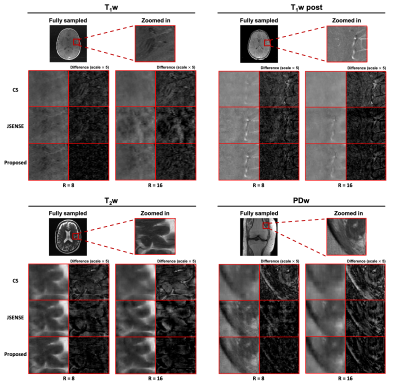 |
14 | Joint Sensitivity Estimation and Image Reconstruction in Parallel Imaging Using Pre-learned Subspaces of Coil Sensitivity Functions
Lihong Tang1, Yibo Zhao2,3, Yudu Li2,3, Rong Guo2,3, Bingyang Cai1, Yao Li1, Zhi-Pei Liang2,3, and Jie Luo1
1School of Biomedical Engineering, Shanghai Jiao Tong University, Shanghai, China, 2Department of Electrical and Computer Engineering, University of Illinois at Urbana Champaign, Urbana, IL, United States, 3Beckman Institute for Advanced Sciences and Technology, University of Illinois at Urbana Champaign, Urbana, Urbana, IL, United States
Accurate estimation of coil sensitivity functions is essential for SENSE-based image reconstruction. This paper presents a new method for joint estimation of coil sensitivity functions and image reconstruction from sparsely sampled k-space data without any auto-calibration data. The proposed method uses a probabilistic subspace model to capture statistical spatial distributions of a given coil system from prior scan data. The proposed method has been validated using experimental data (fastMRI dataset), producing high-quality reconstruction results from calibrationless sparse data (acceleration factor R = 8 or R = 16). The proposed method may further enhance the practical utility of parallel imaging.
|
||
4694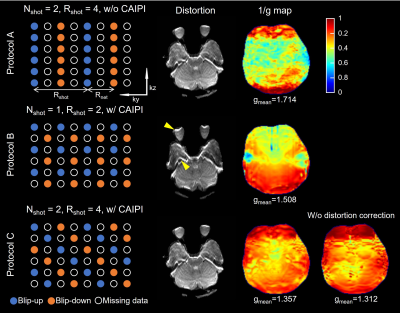 |
15 | Simultaneous Multi-slab DWI Reconstruction with Intrinsic Distortion Correction using Blip-up/down Acquisitions
Jieying Zhang1, Simin Liu1, Erpeng Dai2, Xinyu Ye1, Yang Yu3,4, Yajing Zhang5, Jie Lu3,4, and Hua Guo1
1Center for Biomedical Imaging Research, Department of Biomedical Engineering, School of Medicine, Tsinghua University, Beijing, China, 2Department of Radiology, Stanford, CA, United States, 3Department of Radiology and Nuclear Medicine, Xuanwu Hospital, Capital Medical University, Beijing, China, 4Beijing Key Laboratory of Magnetic Resonance Imaging and Brain Informatics, Beijing, China, 5MR Clinical Science, Philips Healthcare, Suzhou, China
Simultaneous multi-slab imaging (SMSlab) can achieve high-resolution DWI with high SNR efficiency, but image distortions remain a problem. Joint reconstruction of blip-up/down EPI data can correct for distortion and reduce g-factors simultaneously. This study proposed a joint reconstruction framework with intrinsic distortion correction for SMSlab. Three sampling patterns were compared in terms of levels of distortions and g-factors. According to the results, a multi-shot acquisition should be used to reduce the distortion. Combined with the controlled aliasing in parallel imaging (CAIPI) sampling pattern, it can further reduce the g-factors.
|
||
The International Society for Magnetic Resonance in Medicine is accredited by the Accreditation Council for Continuing Medical Education to provide continuing medical education for physicians.